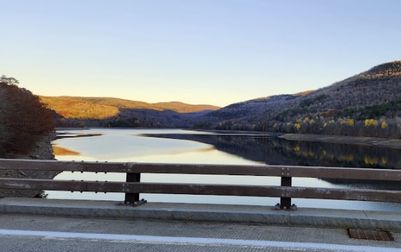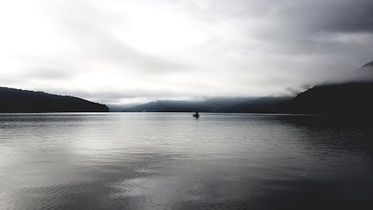
Pepacton Reservoir is one of the most prominent water bodies in New York. It is also known as Downsville Reservoir. It is located in Delaware County on the eastern side of the Delaware River. The beautiful Catskill Mountains surround it in NY.
The reservoir was formed as a result of the construction of the Downsville dam. Moreover, the reservoir impounds over ¼ of the entire flow of the whole branch. This blog post will look at this reservoir’s historical, geographical, and recreational aspects, so stay tuned.
Geography of the Pepacton Reservoir
This reservoir is situated 12 miles south of Delhi Village. It is 101 miles northwest of New York City. Unlike other pools, the Pepacton reservoir is relatively narrow. It is 15 miles long, and the widest point in this reservoir is only 0.7 miles wide.
The deepest point in this reservoir is 160 feet deep. It has a full-water capacity of 430 256 acre-feet. These numbers make the Pepacton reservoir the most significant water body in the area in terms of volume.
Water Supply
Interestingly, this reservoir provides New York City with 25% of its water supply. Water from this reservoir empties into the East Delaware Tunnel, 25.5 miles long. This tunnel is located near the former Pepcaton site.
From there, the water takes an aqueduct to the Rondout reservoir. It further empties into the Delaware aqueduct, which is 85 miles long. From there, it ends up in Putnam City’s West Branch reservoir. Then comes Winchester County’s Kensico reservoir, located towards the North of the Bronx.
From there, the water moves to Hillview Reservoir. Then, it is distributed among the people through a tunnel.
History of the Pepacton River

Pepacton is a native American term. It means the marriage of waters. New York City purchased the land on which this reservoir is situated in the valley in 1942. Sadly, it led to the displacement of more than 900 people. Simultaneously, it also destroyed several towns.
Among the destroyed towns were Union, Arena, Pepacton, and Shavertown. It also resulted in the submersion of ¼ of the Delaware railroad. The dam in Downsville reached its completion in 1954. Its complete flooding took place in 1955.
This reservoir plays a crucial part in the economies of Downsville and New York. Every year, countless tourists flood this reservoir to fish for Trout. However, motorboats aren’t allowed in the reservoir. The visitors can only ride paddle boats, a popular activity in this area.
Physical Features
If we talk about the physical features of the Pepacton Reservoir, it has an elevation of 1207 feet. The reservoir has an area of 5763 acres, while the length is 17 feet. The size of the shoreline is 50.7 miles.
As far as depth is concerned, the reservoir has a maximum depth of 160 feet and a mean depth of 74 feet. As discussed above, it is situated in Delaware County. It is partially located in the town of Andes, while the other half lies in Colchester.
How to Access the Reservoir?
The easiest way to access the reservoir is through boat launches, and there are many of them. These boat launches are designated by the New York City Department of Environmental Protection. However, most of the shoreline can be accessed using the NYC DEP designated land.
To access the area, you need a permit from the NYC DEP. As discussed above, no motorboats are allowed, and you should use only paddle boats. However, each paddle boat should be approved by the NYC DEP.
Recreational Activities at the Pepacton Reservoir
Fishing
Two of the most common fish in this area are the Smallmouth Bass and the Brown Trout. Both of these species are caught at trophy sizes each year. In recent years, people have also begun catching the Channel Catfish. `
The Panfish population is also abundant in these areas. The reservoir is stocked yearly with 8000-9000 brown Trout 8-9 inches in length.
Other fish species in the Pepacton are as follows.
- Alewife
- Rainbow Smelt
- Chain Pickerel
- Common Carp
- Eastern Silvery Minnow
- Golden Shiner
- Spottail Shiner
- Bluntnose Minnow
- Fallfish
- Longnose Sucker
- White Sucker
- Brown Bullhead
- Margined Madtom
- Rock Bass
- Redbreast Sunfish
- Pumpkinseed
- Largemouth Bass
- Black Crappie
- Yellow Perch
Recreational Boating
As discussed earlier, recreational boating is another popular activity at the Pepacton and other reservoirs in the Catskills. The great news is that you don’t need to bring your boat, canoe, or kayak. Here is a step-by-step guide to boating on New York City’s reservoirs.
Choose Your Reservoir
Besides Pepcaton, paddling is allowed in Schoharie, Cannonsville, and Neversink reservoirs. However, it would be best if you had a permit issued on the NYC government’s website.
Find a Boating Rental
Each reservoir has several boat renting companies. You must visit Catskill Watershed Corporation’s website to approach such businesses. They have an up-to-date list of all the ship renting companies in NYC. You can call the companies you are interested in for booking and details.
Get the Boat
Boats are parked at each reservoir. You don’t have to do any heavy lifting, and you also don’t have to walk while carrying the ships into the water. Some businesses will also hand you the keys so you can access your assigned boats. Some companies also have representatives at the site to help you access and return the boats.
Final Thoughts
Whether you want to catch fish, ride a paddle boat or sit by the water to savor the calm, Pepacton has covered you. If there were a word to describe this splendid place, it would be “fascinating.” Make sure to take your camera with you, so you may capture some of the breathtaking sceneries of the Catskills. Whatever you do, make sure not to violate any local laws. Doing so will protect the environment and wildlife while making your experience memorable.
